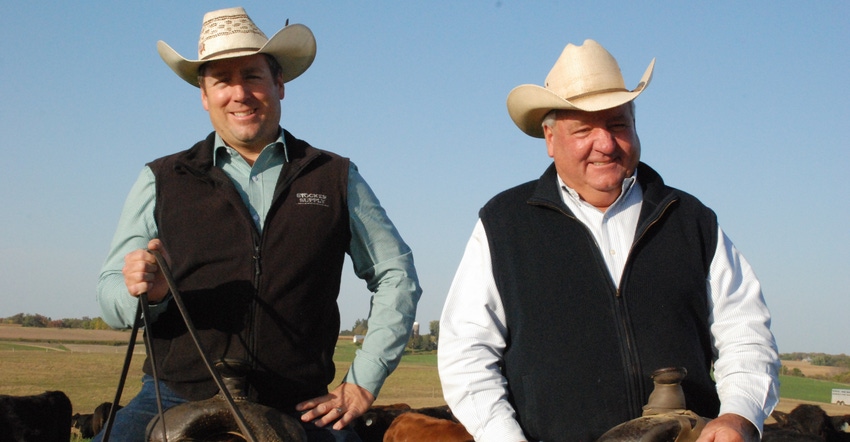This year’s National Stocker Award winner increases stocking rate every year with strategic, intensive grazing.
December 1, 2020

Sponsored Content
Photo: Rush Creek Ranch at Viroqua, Wis., owned and managed by Matt (left) and Reid Ludlow, won this year’s National Stocker Award, sponsored by BEEF and Zoetis.
“If you look at the total pounds we can gain here in Wisconsin in a given season, it always surprises me. We used to put 300 to 350 pounds on them in the summer and now we’re gaining between 400 and 475 pounds,” says Matt Ludlow. He and his father, Reid, own and manage Rush Creek Ranch near Viroqua, Wis., this year’s National Stocker Award winner.
These bountiful gains hinge on meticulously designed and managed rotational grazing that intensified over time.
“When we first came here it was a four or five pasture rotation. By the next year I was working hard on getting that to be a 10 or 12 pasture rotation; one set of cattle rotating through 10-12 pastures,” Reid explains. He established the operation in 1976.
“Even back then, we were stocked twice as heavy as we would have been if we weren’t rotational grazing,” Reid says. “We were stocked at about two head per open (non-wooded) acre for the summer on our ground being rotated; about one per open acre on leased ground, which was set stocked.”
These were primarily 40-acre pastures until 1988 when Wisconsin faced severe drought. That’s when they carved them into 10-acre pastures. That was still the setup when Matt returned to the operation in 2008. Before then, Matt obtained degrees in economics and finance and worked in the financial world.
Then came the decision to divide the pastures into smaller five-acre paddocks, which meant more frequent rotations.
Depending on the size of the cattle, a herd of 650-900 head will rotate through the 32-40 pastures. Think of these as a single unit. Another herd makes its way through a different 32-40 pastures (unit) and so on.
All told, Rush Creek runs eight different herds through the system each year. Today, cattle at Rush Creek Ranch are stocked at 4 to 4.5 head per acre.
“We sit down and try to figure out how many cattle, how much weight we want on a particular unit, and we try to maximize total gain. We put enough cattle out there to keep up with the spring growth,” Reid says.
Reid and Matt move cattle twice each day in the spring and then less frequently through the height of growing season to the point cattle are rotated through pastures every two to three days in the fall of the year. This is all done via horseback.
You’ll find a trailer perpetually hitched to their pickups. These are the type of folks who take their boots off, but leave the spurs strapped to them.
“Our stocking rate has increased about 5% per year,” says Reid. “One of the main advantages when we went from an 8-12 pasture rotation up to 32-40 pastures is manure distribution. The distribution is so much better when you have really heavy stocking density. We operate in an area where the soil and moisture are good enough that the fertility is able to come up.”
The cattle arrive in Wisconsin when grass growth is sufficient, around the first part of May. They start out in the Southeast, where the Ludlows buy flyweight calves (180-280 pounds or so) at auction, via order buyers, one head at a time during the fall and winter. These high-risk calves go to conditioning yards where they’re straightened out and readied to graze ryegrass, primarily in Alabama, Florida and Georgia.
Bottom line, Matt points out being able to run more cattle without having to invest capital in purchasing more acres is a tremendous advantage.
“We’re not trying to get the most absolute gain out of the cattle,” Reid says. “We’re giving up quite a bit by rotating as intensively as we are. There’s no doubt that we’re giving up some because you’re taking away all of their selection ability. We’re giving up individual weight gain to get more gain on that acre.”
Leveraging forage with feed
Increasing gain per acre was behind the Ludlow’s decision several years ago to
utilize supplemental feeding as a way to stockpile and extend forage, while maintaining cattle numbers and performance.
“When we finally decided to feed, that was a hard decision because we were supposed to be a simple summer grazing operation that didn’t have a lot of overhead. When you start to feed, you change a lot of things,” Reid says.
“You’ve got equipment, bunks, more help. But, we felt like we would always be in an area where we could buy feed less expensively than a lot of our competitors because we’re in the upper Midwest. Of course, that doesn’t mean you can’t buy it wrong.”
When it comes to supplementing cattle on grass, Reid believes, “You’ve got to feed something where you’re not hurting the digestion of the forage, and that can be fairly difficult, in our opinion. So, we feed digestible fiber. We’re holding it all together in the bunk with corn silage; the rest of it is byproducts.”
“When you take all of the expense we have wrapped up in these animals, we feel like if we can convert the supplemental feed well enough, while still utilizing the grass, we can make a return on the purchased feed,” Matt says.
BEEF and Zoetis sponsor the National Stocker Award. You can find the full story about Rush Creek in the December issue of BEEF.
About the Author(s)
You May Also Like


.png?width=300&auto=webp&quality=80&disable=upscale)
